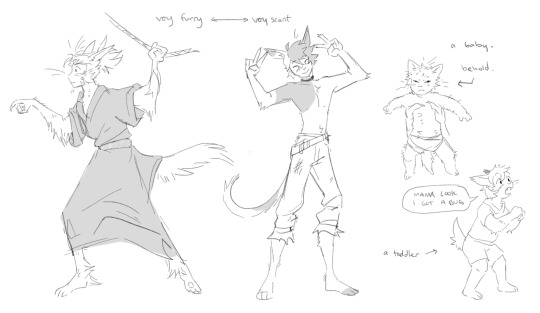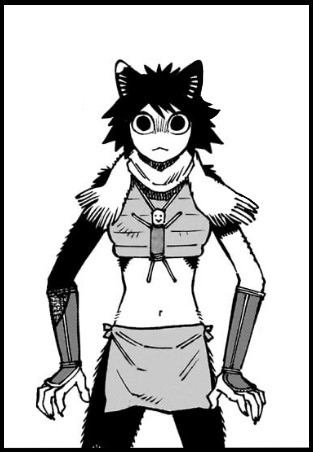#miqo also have whiskers but they’re more like. dog whiskers. they don’t do that much and aren’t as sensitive and you can cut them
Explore tagged Tumblr posts
Note
i have been rotating your ffxiv specbio in my head for several days so if you don't mind my asking, would you be willing to elaborate on some of the specbio for miqo'te and lalafell, if you've not done so already?
OF COURSE im gonna focus a bit more on miqo since the main points of lalas were in that doodle
first of all: miqote would be lesser cats — unable to roar, but able to hiss and purr and chirp and yowl! and they do, do this, often. baby miqo are constantly mewling and chirping and crying, and that’s where a communal child rearing culture comes in handy, because you would not make one parent deal with a very needy (and blind for a month) baby alone. Adult miqo use vocalization for emphasis, along with gesture and expression. They very often express two emotions at once while in conversation with their words/expressions and body language, which makes understanding others’ intentions harder for them. Ex: sad tail, angry ears = upset, happy tail, angry face = teasing, angry tail, angry hands = furious. They might get confused if there’s no tail to denote teasing. Tails are used for balance And emotion, ears are used for listening and emotion, etc, sometimes more so than facial expression, which can sometimes look inexpressive to those who haven’t taught themselves how to emote communicatively among other races.
They are fuzzy all over! like my friend izutsumi. Sun cats are usually less furry, having only translucent-to-tip colored fuzz but some moon keepers can get VERY furry, like Maine coons. It tends to be longest on the forearms, ankles, back (like a cheetah ruff, some miqo have a line of long fur going down to their tail. Whole body Mohawk), and stomach trail, and shortest on the face, most having only peach fuzz up there. Fur length can vary no matter the miqo, and fur pattern also varies - unlike cats, stripes or spots will sometimes color the skin as well. Prominent fur patterns are pretty rare. Please do not shave your miqo’te, it was a bit more popular a few years ago and it turns out it can lead to very patchy or ingrown coats that require shaving for the rest of ever. They have rough tongues and they have brushes and combs, they can take care of their fur, and sometimes other miqos’ fur. Grooming, though, is either for baby or for people you’re close with. Babies are scrungly.

My friend Izutsumi vv


Miqo can digest raw meat, but it’s really more of a you can eat tree bark if you’re lost in the woods situation. The correct thing to do is bring the hunt back home, so everyone can cook and eat. They are not obligate carnivores, but their systems need more meat than a hyur would. They have non-retractable claws, and every miqo has fangs, though sun seekers tend to have bigger chunkier fangs and moon keepers thinner and longer canines. It has to do with the size/type of their prey.
They also have slightly looser skin like a cat. This doesn’t really mean they have wrinkles all over, it means they’re a bit stretchy? They can wriggle their naturally lithe bodies into weird positions to climb and run, and if you give a miqo a mochi kiss it will look like a cartoon. Older male cats (mostly, but it can happen to anyone) will often develop tomcat jowls as they age, and it’s basically balding for a cat in the societal sense, because miqo don’t bald with age. Their fur gets scraggly (but there are hairless cats out there). It’s often considered attractive! Some families consider it a sign that the cat is getting too old.
Miqo’te can see in the dark, and have a reflective layer in their eyes. moon keepers are very adept at darkvision, having near perfect vision at night, and have a little trouble in bright desert sun, while sun seekers have to deal with vastly reduced color perception at night and have pupils that can go very thin to block out sun. Their cheetah face marks help with this!
Lalafell, too, have a difference in eye biology across their species. Only dunesfolk have a thin third eyelid, to repel sand while keeping their eyes open, while plainsfolk have eyes that work similar to a sun seeker. No layered eyelid, just a vertical pupil. All of them have tapetum lucidum.
Also, last point for fun, lalafell stay the same size from 8 years old to 100 years old, and before then they’re about the size of a small hedgehog (baby) to about the size of a kinda small Lala (3-8). A point of annoyance for elezen, who stay the size of a child until they’re 20 or so and then have the worst growing pains in history at a point where complaining about it is less acceptable than getting mad as a kid because your legs hurt. The reason you don’t see very many baby lala is the same reason you don’t see many baby pigeons. You either do and don’t realize it, or they’re VERY SMALL and bundled in blankets or sitting at home and not in the city. A good way to tell if you’re talking to a ten year old or a thirty year old Lala (aside from their intelligence and mannerisms) is by looking at their ears. The tips will darken with age — young lalafell will have light colored ears, sometimes with white fuzz, mature lalafell will have dark ear tips. Good to know for bartenders.
Baby lalafell also have sharp needle teeth. Much like baby miqo, roe, and au ra. Unlike those three, the sharp teeth go away. They’re helpless pink beans when they’re newborns, they will not hesitate to bite you if you bother them too much.
#ask#starlit-warren#ffxiv#my art#your early 20s as an elezen are considered. kind of a rebellious snappy period in your life but this is highly influenced by the fact that#you hurt ALL THE TIME and you have to go to work#anywys! I talked about cats for a long time—#miqo also have whiskers but they’re more like. dog whiskers. they don’t do that much and aren’t as sensitive and you can cut them#maybe less important than dog whiskers even#and their ears elongate as they age too; that’s just a thing that happens. they swivel and move much easier as an adult#roegadyn/au ra have needle teeth as kids and then a bunch of sharp teeth as an adult miqo have needle teeth as kids and fangs as adults#lalas have them as babies and grow out of them (like egg teeth; pretty fast) and everyone’s mothers deserve awards for dealing with this#specbio
34 notes
·
View notes